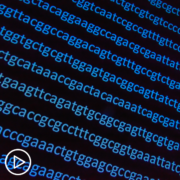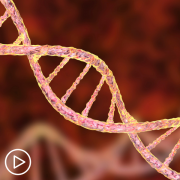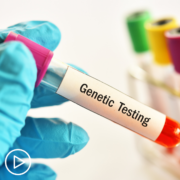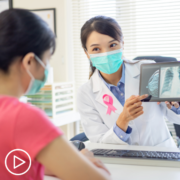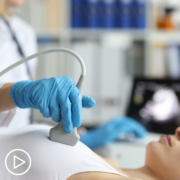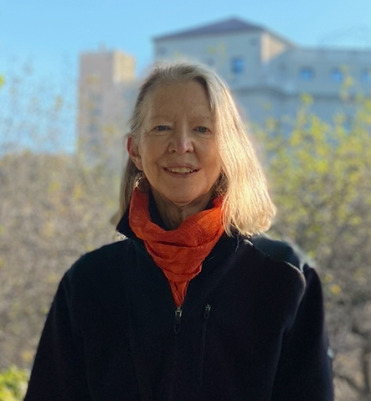Editor’s Note: This resource, Navigating Treatments and Prognosis for Stage 3 Breast Cancer, was originally published by MyHealthTeam.
During a breast cancer diagnosis, your doctor will determine the stage of your cancer. Stages range from 0 to 4, based on the size of the breast tumor and whether the cancer has spread to other organs. If your doctor determines you have stage 3 breast cancer, that indicates you have advanced breast cancer that has begun to impact the tissue surrounding the breast.
Knowing the stage can help your doctor choose the best treatment and predict your prognosis (estimated outlook).
How Is Breast Cancer Stage Determined?
Breast cancer is staged using the TNM staging system, where TNM stands for tumor, node, metastasis. The system looks at the following:
- Tumor — How large is the primary tumor?
- Node — Are there cancer cells in nearby or distant lymph nodes?
- Metastasis — Has the cancer metastasized (spread) to other parts of the body?
A higher degree of cancer spread corresponds to more advanced-stage disease. Understanding the nature of the disease and determining the best treatment options also requires additional information, such as:
- Hormone receptor status — Does the cancer contain estrogen receptors (ERs) or progesterone receptors (PRs), which are types of proteins?
- Tumor grade — How do the abnormal cancer cells look compared to the normal cells?
- Human epidermal growth factor receptor 2 (HER2) status — How high are your levels of the protein HER2?
What Is Stage 3 Breast Cancer?
Also called locally advanced breast cancer, stage 3 breast cancer is a more advanced form of invasive breast cancer. Cancer cells have spread from the milk ducts into the nearby lymph nodes, the skin of the breast, or the chest wall.
Stage 3 breast cancer may further be classified into substages — stage 3A, 3B, or 3C — depending on the size of the breast tumor and the extent of the cancer spread. Notably, breast cancer stages are sometimes referred to using Roman numerals, such as stage III instead of stage 3.
Stage 3A Breast Cancer
Stage 3A breast cancer refers to one of the following situations:
- The doctor doesn’t find a tumor in the breast, or if there is a tumor, it may be of any size. Additionally, cancer is found in four to nine axillary lymph nodes (those that are in the armpit region) or in the lymph nodes closest to the breastbone
- The tumor is larger than 5 centimeters, and there are small groups of breast cancer cells between 0.2 millimeters and 2 millimeters in size in the lymph nodes.
- The tumor is larger than 5 centimeters, and the cancer has spread to one to three axillary lymph nodes or to the lymph nodes near the breastbone.
Stage 3B Breast Cancer
In stage 3B breast cancer, the cancer has spread to the lymph nodes and the chest wall, referring to the protective structures around the lungs. The cancer is also in the skin of the breast, resulting in ulcers or swelling.
Stage 3C Breast Cancer
In stage 3C breast cancer, there may be no sign of cancer in the breast. If there is a tumor, it may be any size and may have spread to the chest wall and/or the skin of the breast. Additionally, the cancer must have spread to one or more of the following places:
- Ten or more axillary lymph nodes
- Lymph nodes above or below the collarbone
- The axillary lymph nodes or lymph nodes near the breastbone
Inflammatory Breast Cancer
Stage 3 breast cancer is classified as inflammatory breast cancer (IBC) when the cancer cells block vessels in the skin of the breast, causing the skin to feel warm and change in appearance.
Treatments for Stage 3 Breast Cancer
Stage 3 breast cancer treatment often starts with chemotherapy, followed by surgery. For cancers with certain genetic mutations, targeted drugs are also used in treatment.
Chemotherapy
Chemotherapy is often the first approach for treating stage 3 breast cancer. Chemotherapy is usually administered as neoadjuvant therapy, meaning it is given prior to surgery. This approach is beneficial in that it can:
- Shrink the tumor to make it easier to remove
- Test that a particular chemotherapy is effective
- In some cases, allow for a less extensive surgical procedure
Mastectomy or Lumpectomy
A mastectomy, which is the removal of the breast tissue, is often required to treat stage 3 breast cancer. Alternatively, a lumpectomy — also referred to as breast-conserving surgery or partial mastectomy — involves the removal of only the breast tumor and some of the surrounding normal tissue.
Many people with stage 3 breast cancer are not eligible for a lumpectomy and likely need a mastectomy to get rid of the tumor completely. However, if neoadjuvant chemotherapy can shrink the tumor enough, a lumpectomy might become a viable option.
Following surgery, some people may choose to have reconstructive surgery to restore the appearance of their breasts.
Radiation
Radiation therapy is often administered following an operation to kill off any remaining breast cancer cells that may have been missed by treatment.
Lymph Node Dissection
Lymph nodes containing cancer cells must also be removed. An axillary lymph node dissection is done to remove the lymph nodes in the armpit. The procedure is usually performed at the same time as a mastectomy.
Hormonal Therapy
Some breast cancers contain proteins called hormone receptors on the surface of breast cancer cells. The hormone receptors that play a role in breast cancer progression are the estrogen receptors and progesterone receptors.
Hormone receptor-positive stage 3 breast cancers can be treated with hormonal therapy drugs such as tamoxifen or exemestane (sold as Aromasin), which specifically target the hormone receptors.
Targeted Therapy
Targeted therapy drugs work by stopping the function of a particular protein or group of proteins. HER2 is a protein that is present at high levels in some breast cancers and affects how the cancer grows. HER2-positive stage 3 cancers may be treated with drugs that specifically target the HER2 protein.
Immunotherapy
If breast cancer cells are negative for ER, PR, and HER2, the cancer is called triple-negative breast cancer. Triple-negative breast cancer is difficult to treat effectively with standard treatments, so newer forms of treatment like immunotherapy may be used to improve outcomes.
Immunotherapy drugs work by interacting with a person’s immune system so that it can recognize and fight the cancer cells. Pembrolizumab (sold as Keytruda) is an immunotherapy drug that can be used along with chemotherapy to treat triple-negative stage 3 breast cancer that has returned or spread after surgery.
Prognosis for Stage 3 Breast Cancer
Stage 3 breast cancer is an advanced stage disease, so prompt treatment is crucial for improving the prognosis.
Overall, stage 3 breast cancer has a somewhat favorable prognosis with a five-year survival rate as high as 86 percent. This means 86 percent of people with the condition live at least five years after being diagnosed. This rate can vary depending on the exact substage of cancer. For instance, IBC has a markedly lower survival rate, closer to 41 percent.
Hormonal therapy and other targeted drugs have helped to improve outcomes for cancers with specific genetic features. Some people may be encouraged to participate in clinical trials, which can advance the discovery of new effective treatments for stage 3 breast cancer.
Talk With Others Who Understand
MyBCTeam is the social network for people with breast cancer and their loved ones. On MyBCTeam, more than 58,000 members come together to ask questions, give advice, and share their stories with others who understand life with breast cancer.
Have you or a loved one been diagnosed with stage 3 breast cancer? Share your experiences in the comments below, or start a conversation by posting on MyBCTeam.





